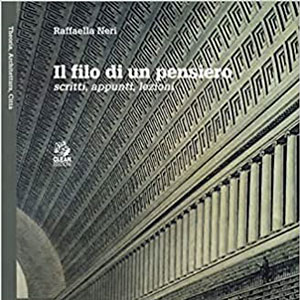
Theory and project. The continuity of a comparison
Increasingly, architectural design is becoming a project of
specialization, focused on exalting a specific aspect. Through
captivating images, projects that exalt sculptural forms are told,
through technical reports the technological efficiency of architectures
that can be likened to real "machines" is told. Increasingly rare, vice
versa, are the occasions in which an architectural project is
accompanied by a report that makes explicit its reasons and
compositional principles.
The project and the elaboration of the project represent the centrality
around which the writings of Raffaella Neri’s book orbit. In the
different themes addressed, the nature of the research takes a
different point of view from what happens frequently in the
contemporary world, it is not focused on specificities but on the
characters of generality, on the recurrences that allow to give an
objective validity to the project. Generality of choices, generality of
principles, leading to an ability to hold together, as a director does
along the making of a film, the different aspects of which an
architectural project is composed.
In order to divert attention from the specifics, trying to identify
principles and put order among the problems that a project in its
complexity must solve, an entire first part of the book focuses on the
role that theory can invest. Theory, which the author understands as a
necessary foundation for elaborating projects through which one can
confront oneself, projects in which the concluding formal solution
recognizably returns the reason for the building itself. Therefore, in
dealing with the various aspects that make up the design process, it is
necessary to pursue the overall purpose of the work, the principles on
which it is based, and not to be sidetracked by individualisms.
The book is composed of thoughts and reflections, defined over almost
thirty years of the author’s training and academic career, put on
paper on several occasions; university research and lectures,
publications, project seminars and international conferences. The
collection is thus rich in different themes and case studies,
recurring, however, are the theses that the author tries to verify,
comparing and abstracting, the lessons offered by historical cities and
designers assumed as masters. Theses that belong to a twofold scaling
of the project: at the scale of the building, we focus on the role of
construction as a fundamental act of architecture; at the urban scale,
on the contrary, the focus is on the outside of the artifact and the
relationships that architectures are able to establish with each other
and with the context that surrounds them are investigated.
Construction is approached not in a technical way as the engineer
might, but by investigating the encounter between the problem of
construction and the problem of expression. Architectures by designers
such as Peter Behrens, Mies van der Rohe, the architects of the Chicago
School and the masters of Italian reinforced concrete are identified as
exceptional case studies capable of enhancing the role of construction.
The construction choices and principles that are able to be deduced
through the analysis of such projects allow us to understand how the
construction narrative can become the best opportunity to manifest the
meaning of the building.
Instead, the relationships between architectures, and between
architectures and context, represent the capacity to construct places
and define the identity of those places. This capacity becomes the main
objective to be pursued during urban design if, as the author argues,
through urban design we aspire to an idea of the city understood as a
composition of places, a sequence of different but related places
belonging to the urban sphere, public space and the space of residence.
The title of the book, the thread of a thought, certainly refers to
Raffaella Neri’s already mentioned personal journey, however in
the choices of themes and the ways of interpreting them there seems to
be a general thread that refers to an attitude, to a posture with which
to approach the project. A way of doing architecture that is based on
knowledge as the architect’s first act of awareness and
responsibility, which seeks an objective validity of the project
through the development of the deductive activity of recognizable rules
and principles in a rational way. A way of doing architecture that, in
conclusion, by framing the project as an opportunity for confrontation,
as a continuous opportunity for growth, and by addressing itself
primarily to students and project enthusiasts, belongs to a way of
doing architecture school..
Marvin Cukaj
Author:
Raffaella Neri
Title:
Il filo di un pensiero
Subtitle:
scritti, appunti, lezioni
Language:
italian
Publisher:
CLEAN edizioni
Characteristic:
16x24 cm, 202 pages, paperback, black and white
ISBN:
9788884976765
Year:
2020